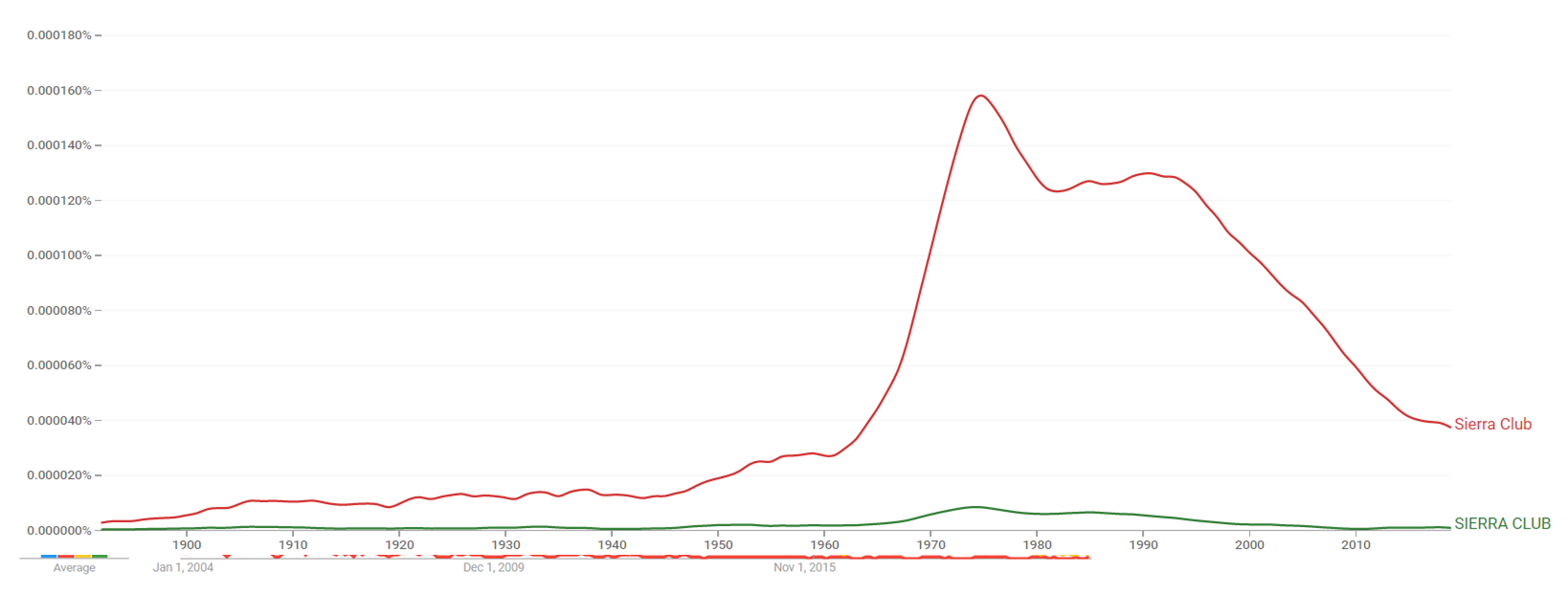Timeline of The Sierra Club
This is a timeline of The Sierra Club, an important and early environmental organization in the United States.
Big picture
| Period | Key trend/development |
|---|---|
| 1890s–1960s | During the first decades from its foundation, many of The Sierra Club’s efforts involve fighting efforts to dam rivers.[1] |
| 1980s | The Sierra Club experiences considerable growth as it garners support for opposing the policies of the often described as "anti-environmentalist" U.S. Secretary of the Interior James G. Watt, who advocates use, rather than protection, of wilderness.[2] |
Timeline
| Year | Event type | Event | Geographical location |
|---|---|---|---|
| 1864 | Antecedent | Scottish-American naturalist John Muir joins American diplomat Robert Underwood Johnson in a campaign to create a large Yosemite National Park surrounding the much smaller state park which is created the same year as a public trust.[1][3] | California |
| 1872 | Foundation | Yellowstone is founded as the first national park of the United States.[1] | Wyoming, Montana, Idaho |
| 1892 (May 28) | Foundation | The Sierra Club is founded by a San Francisco group of professors, businessmen, and other professionals led by John Muir.[4][1] | San Francisco |
| 1892 | Program launch | The Sierra Club’s first conservation campaign is launched, as an effort to defeat a proposed reduction of Yosemite National Park’s boundaries.[1] | |
| 1901 | Program launch | The Sierra Club sponsors the first annual High Trip, with at least 250 people spending a month in Yosemite, moving camp 1-2 times a week.[5] | California |
| 1904 | LeConte Memorial Lodge, a current National Historic Landmark, is built by The Sierra Club in 1903 in memory of Joseph LeConte, one of the founding members of The Sierra Club".[6] | ||
| 1907 | A seven-year environmental struggle begins between The Sierra Club and the proposal of a reservoir in the Hetch Hetchy, a project that follows the need for additional water for growing San Francisco. However, the United States Congress would flood the valley in 1913.[1][7] | ||
| 1911 | Organization | The first official chapter of The Sierra Club starts in Southern California.[1] | Southern California |
| 1914 | John Muir dies.[8] | ||
| 1915 | The Sierra Club is awarded $10,000 to construct the John Muir Trail, a long-distance trail in the Sierra Nevada mountain range of California, passing through Yosemite, Kings Canyon and Sequoia National Parks.[8] | California | |
| 1916 | Endorsement | The Sierra Club supports bill that would create the National Park Service.[1] | |
| 1919 | Sierra Club appoints American photographer and environmentalist Ansel Adams custodian of LeConte Memorial Lodge in Yosemite, a position Adams would held until 1927.[9] | ||
| 1920 | Infraestructure development | The Sierra Club develops a cable system that provides access for visitors without technical rock climbing ability to the summit of Half Dome, a granite dome at the eastern end of Yosemite Valley in Yosemite National Park.[10] | California |
| 1927 | Conservationist Aurelia Harwood becomes the first female President of The Sierra Club.[11] | ||
| 1936 | Program launch | The Sierra Club grading system is created to classify hikes and climbs in the Sierra Nevada. The system divides climbs into six classes, class 1 being easy and class 6, severe. This classification would be modified in 1938.[12] | |
| 1937 | Program launch | The Sierra Club develops Sierra Club Ski-Mountaineering Test as a standard for ski tour leaders and advanced participants.[13] | |
| 1948 | Endorsement | Sierra Club backs a plan for a ski resort at Mineral King, a subalpine glacial valley located in the southern part of Sequoia National Park. However, the project would be abandoned due to inadequate roads.[14] | |
| 1951 | The Sierra Club oposes federal government’s interest in damming Dinosaur National Monument in Colorado and Utah.[1] | ||
| 1952 | As rock climbing becomes more popular, the 1938 Sierra Club classification system is modified further into the Yosemite Decimal System.[12] | ||
| 1960 | Organization | The The Sierra Club Foundation is established as a nonprofit, with the purpose of providing financial support to The Sierra Club and other environmental organizations for tax deductible work.[1] | |
| 1960 | Organization | Sierra Club Books is founded as the publishing division of Sierra Club. Along its history, Sierra Club Books would publish important books such as The Population Bomb and Fifty Classic Climbs of North America. | |
| 1964 | Background | The United States Congress passes the Wilderness Act, which establishes that wilderness lands have intrinsic worth and deserve to be protected in their natural state, unaltered by humans and free for everyone to experience and enjoy.[15][1] | |
| 1970 | Organization | Sierra Club North Carolina Chapter is established.[16] | North Carolina |
| 1971 | Organization | The Sierra Club Legal Defense Fund is launched as a group whose task is to handle The Sierra Club’s mounting litigation.[2] | |
| 1980–1983 | Sierra Club’s membership nearly doubles to 346,000 during this period.[2] | ||
| 1987 | Policy | LeConte Memorial Lodge, built by Sierra Club, is declared a National Historic Landmark.[6] | |
| 1991 | Organization | The Sierra Student Coalition (SSC) is founded as the national student chapter of Sierra Club. | Washington, D.C |
| 1992 | Organization | Sierra Club du/of Canada (SCC) is founded as an equivalent organization. It is developed from Canadian chapters of the United States Sierra Club. SCC would focus its national campaigns in four program areas: health and environment, protecting biodiversity, atmosphere and energy, and supporting a transition to sustainable economy.[1] | Canada |
| 1996 | Environmental activist Adam Werbach becomes the youngest person ever elected as national president of The Sierra Club, at the age of 23.[17] | ||
| 1999 | The Sierra Club receives a multi-year grant to fund the establishment of an Environmental Justice Program and open five Environmental Justice offices across the United States.[18] | ||
| 2006 | The Sierra Club manages to prevent the George W. Bush Administration from allowing commercial logging in Giant Sequoia National Monument, a 328,000 acre U.S. National Monument located in the southern Sierra Nevada in eastern central California.[19] | California | |
| 2008 | The Sierra Club manages to block a wolf killing initiative in Idaho, Montana and Wyoming.[19] | Idaho, Montana, Wyoming | |
| 2011 | Sierra Club and Tucson–based Center for Biological Diversity file a lawsuit challenging the Bureau of Land Management oil and gas leases in Fresno and Monterey counties, arguing that BLM has failed to consider the possibility that these leases could be fracked, will all the entailing risks. By 2013, the court would agree that BLM broke the law, with BLM taking a voluntary remand to correct its deficient environmental analysis.[20] | ||
| 2016 | Sierra Club changes the name of LeConte Memorial Lodge to Yosemite Conservation Heritage Center after finding that Sierra Club founding member Joseph LeConte, for which the lodge was originally named, is now viewed as a racist and white supremacist.[6][21] |
Sierra Club presidents
| Period | President[11] |
|---|---|
| 1892-1914 | John Muir (founder of The Sierra Club) |
| 1915-1917 | Joseph Nisbet LeConte (son of The Sierra Club founding member Joseph LeConte) |
| 1917-1919 | William Edward Colby |
| 1919-1922 | William F. Badè |
| 1922-1924 | Clair S. Tappaan |
| 1924-1925 | Robert M. Price |
| 1925-1927 | Walter L. Huber |
| 1927-1928 | Aurelia Harwood |
| 1928-1931 | Duncan McDuffie |
| 1931-1933 | Phil S. Bernays |
| 1933-1935 | Francis P. Farquhar |
| 1935-1937 | Ernest Dawson (father of mountaineer Glen Dawson) |
| 1937-1940 | Joel Henry Hildebrand |
| 1940-1941 | Francis D. Tappaan |
| 1941-1943 | Walter A. Starr (father of mountain climber Walter A. Starr, Jr.) |
| 1943-1946 | Duncan McDuffie |
| 1946-1948 | Bestor Robinson |
| 1948-1949 | Francis P. Farquhar |
| 1949-1951 | Lewis F. Clark |
| 1951-1953 | Harold E. Crowe |
| 1953-1955 | Richard M. Leonard |
| 1955-1957 | Alexander Hildebrand |
| 1957-1959 | Harold C. Bradley |
| 1959-1961 | Nathan C. Clark |
| 1961-1964 | Edgar Wayburn |
| 1964-1966 | William Siri |
| 1966-1967 | George Marshall |
| 1967-1969 | Edgar Wayburn |
| 1969-1971 | Phillip Berry |
| 1971-1973 | Raymond Sherwin |
| 1973-1974 | Laurence I. Moss |
| 1974-1976 | Kent Gill |
| 1976-1977 | Brant Calkin |
| 1977-1978 | William Futrell |
| 1978-1980 | Theodore Snyder |
| 1980-1982 | Joseph Fontaine |
| 1982-1984 | Denny Shaffer |
| 1984-1986 | Michele Perrault |
| 1986-1988 | Lawrence Downing |
| 1988-1990 | Richard Cellarius |
| 1990-1991 | Susan Merrow |
| 1991-1992 | Phillip Berry |
| 1992-1993 | H. Anthony Ruckel |
| 1993-1994 | Michele Perrault |
| 1994-1996 | Robbie Cox |
| 1996-1998 | Adam Werbach |
| 1998–2000 | Chuck McGrady |
| 2000-2001 | Robbie Cox |
| 2001-2003 | Jennifer Ferenstein |
| 2003-2005 | Larry Fahn |
| 2005-2007 | Lisa Renstrom |
| 2007-2008 | Robbie Cox |
| 2008-2010 | Allison Chin |
| 2010-2012 | Robin Mann |
| 2012-2013 | Allison Chin |
| 2013-2015 | David Scott |
| 2015-2017 | Aaron Mair |
| 2017- | Loren Blackford |
Visual data
Google Trends
The comparative chart below shows Google Trends data for Sierra Club (Topic), Rails-to-Trails Conservancy (Nonprofit organization), Natural Resources Defense Council, Inc. (Non-profit) and Environmental Working Group (Corporation) from January 2004 to April 2021, when the screenshot was taken. Interest is also ranked by country and displayed on world map.[22]

Google Ngram Viewer
The chart below shows Google Ngram Viewer data for Sierra Club, from 1892 to 2019.[23]

Wikipedia Views
The chart below shows pageviews of the English Wikipedia article Sierra Club, on desktop from December 2007, and on mobile-web, desktop-spider, mobile-web-spider and mobile app, from July 2015; to March 2021. A data gap on desktop observed from October 2014 to June 2015 is the result of Wikipedia Views failure to retrieve data.[24]

External links
References
- ↑ 1.00 1.01 1.02 1.03 1.04 1.05 1.06 1.07 1.08 1.09 1.10 1.11 "Sierra Club (The)". learningtogive.org. Retrieved 28 June 2017.
- ↑ 2.0 2.1 2.2 "Finding Aid to The Sierra Club Board of Directors meeting minutes, 1892-1995". cdlib.org. Retrieved 28 June 2017.
- ↑ Michael P. Cohen, The History of the Sierra Club, 1892–1970 (San Francisco: Sierra Club Books, 1988)
- ↑ "Sierra Club". britannica.com. Retrieved 8 July 2017.
- ↑ McClaran, Mitchel P. "Recreational Pack Stock Management in Sequoia and Kings Canyon National Parks". arizona.edu. Retrieved 8 July 2017.
The Sierra Club sponsored their first annual High Trip in 1901. As many as 250 people spent a month in the backcountry, moving camp 1-2 times a week.
- ↑ 6.0 6.1 6.2 "Sierra Club renames Yosemite stone hut". uniondemocrat.com. Retrieved 28 June 2017.
- ↑ Muir, John (1912). "Hetch Hetchy Valley". The Yosemite. New York: The Century Co. Retrieved 7 July 2017.
- ↑ 8.0 8.1 ""The Mountains are Calling and I Must Go"". ushistoryscene.com. Retrieved 8 July 2017.
- ↑ Starr, Kevin. The Dream Endures: California Enters the 1940s. Retrieved 28 June 2017.
- ↑ "Half Dome Cables Modeling and Visitor Use Estimation Final Report" (PDF). nps.gov. Retrieved 7 July 2017.
In 1920, The Sierra Club develope d a cable system that provides access to the summit of Half Dome for visitors without technical rock climbing ability.
- ↑ 11.0 11.1 "Sierra Club Presidents". sierraclub.org. Retrieved 28 June 2017.
- ↑ 12.0 12.1 Secor, R. J. The High Sierra: Peaks, Passes, Trails. Retrieved 28 June 2017.
- ↑ "Ski-Mountaineering Skills: Backcountry Travel". skimountaineerssectionlachaptersc.org. Retrieved 7 July 2017.
In 1937, The Sierra Club adopted the Ski Mountaineering Test as a standard for ski tour leaders and advanced participants.
- ↑ "Walt Disney's Mineral King". yesterland.com. Retrieved 7 July 2017.
In 1948, The Sierra Club had backed a plan for a ski resort at Mineral King, but the inadequate road killed the project
- ↑ "50 Years Later: How the Civil Rights Act and the Wilderness Act Changed the U.S." sierraclub.org. Retrieved 7 July 2017.
The Wilderness Act established that wilderness lands have intrinsic worth and deserve to be protected in their natural state, unaltered by humans and free for everyone to experience and enjoy.
- ↑ "Sierra Club (National)". capefearsierraclub.com. Retrieved 28 June 2017.
- ↑ "New York Times: "Sierra Club Gets a Young New Face" June 2, 1996". The New York Times. Retrieved 28 June 2017.
- ↑ "A Deeper Shade of Green". sierraclub.org. Retrieved 7 July 2017.
In 1999, The Sierra Club received a multi-year grant to fund the establishment of an Environmental Justice Program and open five EJ offices around the country.
- ↑ 19.0 19.1 "The Sierra Club". thoughtco.com. Retrieved 7 July 2017.
In 2006, The Sierra Club prevented the Bush Administration from allowing commercial logging in Giant Sequoia National Monument.
- ↑ "Ventana chapter". ventanasierraclub.org. Retrieved 28 June 2017.
- ↑ "Sierra Club Discovers Founder Was a White Supremacist". breitbart.com. Retrieved 28 June 2017.
- ↑ "Sierra Club, Rails-to-Trails Conservancy, Natural Resources Defense Council, Inc. and Environmental Working Group". Google Trends. Retrieved 14 April 2021.
- ↑ "Sierra Club". books.google.com. Retrieved 16 April 2021.
- ↑ "Sierra Club". wikipediaviews.org. Retrieved 16 April 2021.